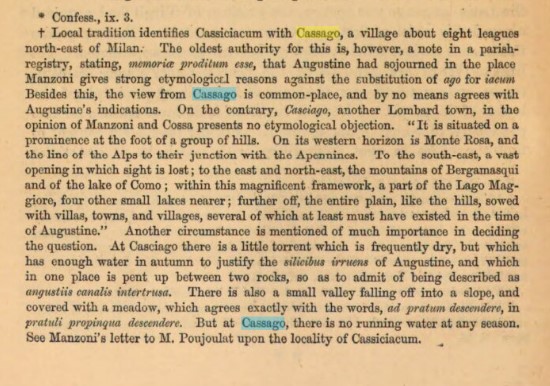Contenuto
Percorso : HOME > Cassiciaco > Vexata quaestio > The Contemporary ReviewThe Contemporary Review

Il brano relativo al Cassiciacum agostiniano
THE CONTEMPORARY REVIEW
vol. V maggio-agosto 1867
Alexander Strahan Publisher 56 Ludgate Hill London 1867 pag. 152
La nota in margine al testo riprende formalmente il testo manzoniano sull'argomento grazie alla mediazione dell'opera di Poujoulat che descrive la Vita di sant'Agostino.
Pag. 152
Local tradition identifies Cassiciacum with Cassago, a village about eight leagues north-east of Milano. The oldest authority for this is, however, a note in a parish-registry, stating, memoriae proditum esse, that Augustine had sojourned in the place. Manzoni gives strong etymological reasons against the substitution of ago for iacum. Besides this, the view from Cassago is common-place, and by no means agrees with Augustine's indications.
On the contrary, casciago, another Lombard town, in the opinion of Manzoni and Cossa presents no etymological objection. "It is situated on a prominence at the foot of a group of hills. On ita western horizon is Monte Rosa, and the line of the Alps to their junction with the Apennines. To the south-east, a vast opening in wich sight is lost; to the east and nord-east, the montains of Bergamasqui and of the lake of Como; within this magnificent framework, a part of the Lago Maggiore, four other small lakes nearer; further off, the entire plain, like the hills, sowed with villas, towns, and villages, several of which et least must have existed in the time of Augustine."
Another circumstance is mentioned of much importance in deciding the question. At Casciago there is a little torrent which is frequently dry, but which has enough water in autumn to justify the silicibus irruens of Augustine, and which in one place is pent up between two rocks, so as to admit of being described as angustiis canalis intertrusa.
There is also a small valley falling off into a slope, and covered with a meadow, which agress exactly with the words, ad pratum descendere, in pratuli propinque descendere. But at Cassago, there is no running water at any saeson.
See Manzoni's leter to M. Poujoulat upon the locality of Cassiciacum.
La tradizione locale identifica Cassiciacum con Cassago, paese a circa otto leghe a nord-est di Milano. La pi¨ antica documentazione in tal senso Ŕ per˛ una nota in un registro parrocchiale, in cui si afferma, memoriae proditum esse, che Agostino aveva soggiornato nel luogo. Manzoni fornisce forti ragioni etimologiche contrarie alla sostituzione di ago con iacum. Oltre a ci˛ la tesi di Cassago Ŕ un luogo comune, e no Ŕ per nulla in accordo con le indicazioni di Agostino. Casciago, altro paese lombardo, secondo Manzoni e Cossa, invece, non presenta alcuna obiezione etimologica. "Si trova su un rilievo ai piedi di un gruppo di colline. Sull'orizzonte occidentale Ŕ il Monte Rosa, e la linea delle Alpi al loro incrocio con l'Appennino. A sud-est, si trova un vasto orizzonte in cui non si vede la fine; ad est e nord-est, le montagne del Bergamasco e del lago di Como; in questa magnifica cornice, una parte del Lago Maggiore, altri quattro laghetti pi¨ vicini; pi¨ in lÓ, tutta la pianura, come le colline, seminato di ville, cittÓ e villaggi, molti dei quali almeno devono essere esistiti al tempo di Agostino".
Viene menzionata un'altra circostanza di grande importanza nel decidere la questione. A Casciago c'Ŕ un piccolo torrente spesso asciutto, ma che d'autunno ha abbastanza acqua per giustificare il silicibus irruens di Agostino, e che in un punto Ŕ rinchiuso tra due rocce, tanto da poter essere descritto come angustiis canalis intertrusa. C'Ŕ anche una piccola valle che sfocia in un pendio, ed Ŕ ricoperta da un prato, che corrisponde esattamente con le parole, al pratum discendere, in pratuli propinque discendere. Ma a Cassago non c'Ŕ acqua corrente in nessuna stagione. Si veda la lettera del Manzoni a M. Poujoulat sulla localitÓ Cassiciacum.

